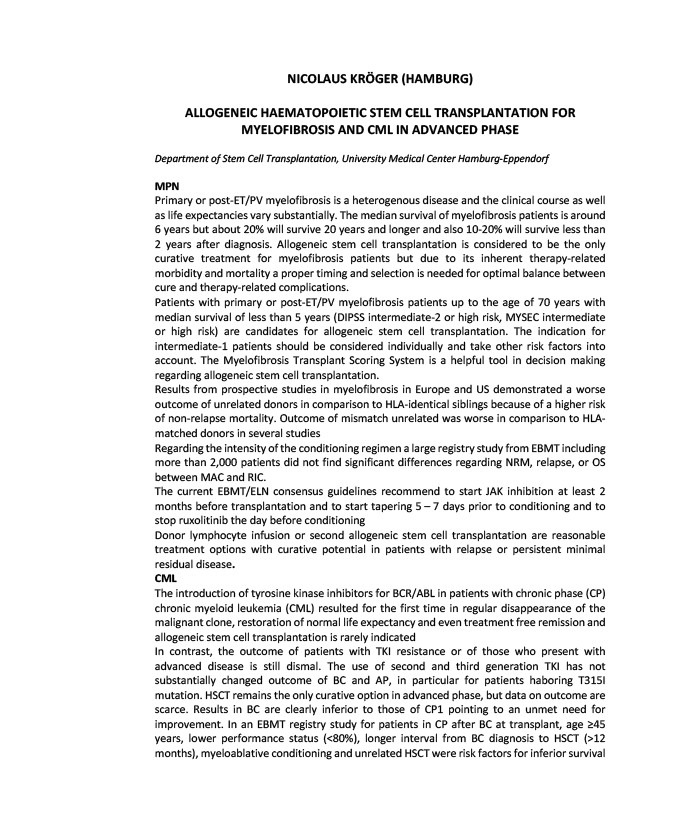
NICOLAUS KRÖGER (HAMBURG)
ALLOGENEIC HAEMATOPOIETIC STEM CELL TRANSPLANTATION FOR
MYELOFIBROSIS AND CML IN ADVANCED PHASE
Department of Stem Cell Transplantation, University Medical Center Hamburg-Eppendorf
MPN
Primary or post-ET/PV myelofibrosis is a heterogenous disease and the clinical course as well
as life expectancies vary substantially. The median survival of myelofibrosis patients is around
6 years but about 20% will survive 20 years and longer and also 10-20% will survive less than
2 years after diagnosis. Allogeneic stem cell transplantation is considered to be the only
curative treatment for myelofibrosis patients but due to its inherent therapy-related
morbidity and mortality a proper timing and selection is needed for optimal balance between
cure and therapy-related complications.
Patients with primary or post-ET/PV myelofibrosis patients up to the age of 70 years with
median survival of less than 5 years (DIPSS intermediate-2 or high risk, MYSEC intermediate
or high risk) are candidates for allogeneic stem cell transplantation. The indication for
intermediate-1 patients should be considered individually and take other risk factors into
account. The Myelofibrosis Transplant Scoring System is a helpful tool in decision making
regarding allogeneic stem cell transplantation.
Results from prospective studies in myelofibrosis in Europe and US demonstrated a worse
outcome of unrelated donors in comparison to HLA-identical siblings because of a higher risk
of non-relapse mortality. Outcome of mismatch unrelated was worse in comparison to HLA-matched
donors in several studies
Regarding the intensity of the conditioning regimen a large registry study from EBMT including
more than 2,000 patients did not find significant differences regarding NRM, relapse, or OS
between MAC and RIC.
The current EBMT/ELN consensus guidelines recommend to start JAK inhibition at least 2
months before transplantation and to start tapering 5 – 7 days prior to conditioning and to
stop ruxolitinib the day before conditioning
Donor lymphocyte infusion or second allogeneic stem cell transplantation are reasonable
treatment options with curative potential in patients with relapse or persistent minimal
residual disease.
CML
The introduction of tyrosine kinase inhibitors for BCR/ABL in patients with chronic phase (CP)
chronic myeloid leukemia (CML) resulted for the first time in regular disappearance of the
malignant clone, restoration of normal life expectancy and even treatment free remission and
allogeneic stem cell transplantation is rarely indicated
In contrast, the outcome of patients with TKI resistance or of those who present with
advanced disease is still dismal. The use of second and third generation TKI has not
substantially changed outcome of BC and AP, in particular for patients haboring T315I
mutation. HSCT remains the only curative option in advanced phase, but data on outcome are
scarce. Results in BC are clearly inferior to those of CP1 pointing to an unmet need for
improvement. In an EBMT registry study for patients in CP after BC at transplant, age ≥45
years, lower performance status (<80%), longer interval from BC diagnosis to HSCT (>12
months), myeloablative conditioning and unrelated HSCT were risk factors for inferior survival